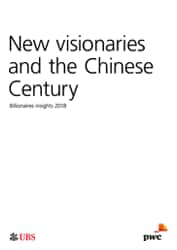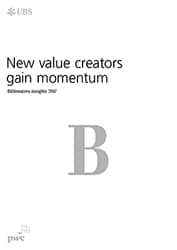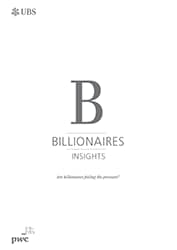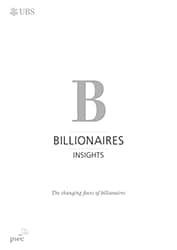2020 Billionaires Insights out now!
Billionaires, existing and newly minted, have been at the forefront of addressing the pandemic. Tech innovators have been driving new ways of living with the Covid-19 reality – accelerating the process as digital solutions at times become the only way. Billionaire philanthropists have donated unprecedented amounts to help tackle the disease and its consequences. Others are pursuing innovative approaches to investment that emphasise sustainability and corporate responsibility.
Billionaires report archive
2019 - The billionaire effect
Billionaire-controlled companies tend to outperform the market. Billionaires are masters of calculated risks and they focus on their core businesses with determination. “The billionaire effect – Billionaires insights 2019” report conducted by PwC and UBS zooms in on this fact and analyzes new trends among billionaires. In its sixth publication, the report provides a better understanding of the ultra-wealthy around the world and the economic and societal impact billionaires have.
2018 – New visionaries and the Chinese Century
Last year, the world’s billionaires’ assets grew by USD 1.4 trillion to USD 8.9 trillion – the most substantial annual increase and the greatest wealth ever. There were 332 new billionaires, 199 of which self-made entrepreneurs. China, the fastest growing billionaire market worldwide, is producing two new billionaires a week. The «Billionaires Insights 2018 – New Visionaries and the Chinese Century» report conducted by PwC and UBS focuses on this staggering growth. APAC comes out on top and is unmatched when it comes to generating wealth. The report also analyses the enormous shift of wealth that is predicted for the next generation.
PwC and UBS have continued their analysis of wealth generation and respective emerging trends in their fifth report on billionaires’ wealth. Their report is based on data including 2,158 billionaires from 43 countries in the Americas, EMEA and APAC, encompassing 98% of the global billionaire wealth. It takes a close look at billionaires’ changing fortunes and needs.
INNOVATION
Leading innovators:
Billionaires have driven almost 80% of the 40 main breakthrough innovations over the last 40 years. Approximately 70% are technology-related and 80% of the companies behind them are based in the Americas, with 20% in APAC.


INDUSTRY
The vanguard of the ‘fourth industrial revolution’:
One hundred and ninety-nine entrepreneurs became billionaires for the first time in 2017 – some of them in the vanguard of the ‘Fourth Industrial Revolution’.
GROWTH
The China phenomenom:
Globally, billionaire wealth increased by USD 1.4 trillion to USD 8.9 trillion in 2017, its greatest absolute growth ever, with China minting 2 billionaires a week.


TECHNOLOGY
Shenzen challenges Silicon Valley:
A new cohort of Chinese entrepreneurs is challenging Silicon Valley, amid rising tensions over trade and intellectual property. With 50 unicorns produced in China and 62 in the US, the Chinese prove restless innovators and disruptors.
GLOBAL
From the family business to business families:
As the next generation of sons and daughters grows up, so there is rising entrepreneurial spirit in billionaire families across the world.


SUCCESSION
Leading 21st Century families forward
New multi-generational families are being created, recognizing the need to plan for succession. In 2017 alone, 44 heirs inherited more than a billion dollars each (56% Americas, 28% EMEA, 16% APAC), totalling USD 189 billion.
SUSTAINABILITY
New wealth, new impact:
While sustainable investing is becoming mainstream, as millennials assume roles in family offices and philanthropic organizations the trend is likely to grow stronger.


OUTLOOK
China’s young entreprenueurs set for multi-year growth:
China’s young entrepreneurs are set to swell the ranks of the world’s billionaires for years to come.

2017 – New value creators gain momentum
What a difference a year makes. In last year’s report, we asked the question “Are billionaires feeling the pressure?” as billionaire wealth dropped. This year we’ve seen a dramatic return to growth. Billionaire wealth rose 17% in 2016, double the rate of the MSCI AC World Index. Despite a period of heightened geopolitical uncertainty, the world’s ultrawealthy are flourishing.
There are startling figures: for the first time in history there are now more billionaires in Asia than in the US. This year’s 145 new billionaires employ at least 2.8 million people. We uncover the increasingly powerful role played by networks: more and more families are working together on new ventures and younger entrepreneurs are tapping into a broader group of contacts to orchestrate deals.
Billionaires are enjoying resurgent growth and creating new legacies, driven by a shift in the geography of global influence. We can expect many more such shifts in the future as Asia, and in particular China, continues to grow in stature. We look forward to charting these developments in the years to come.
Return to growth:
After a pause in 2015, expansion in billionaire wealth has continued. Globally, the total wealth of billionaires rose by 17% in 2016, up from USD5.1 trillion to USD6.0 trillion. There was a 10% rise in the number of billionaires globally to 1,542.


The Asian Century: outpacing the United States:
In a landmark year, the number of Asian billionaires on our database exceeded US billionaires for the first time. Powered by the rise of China’s entrepreneurs in an exceptional year, the number of Asian billionaires rose by almost a quarter to 637. By comparison, the US is home to 563 billionaires and Europe to 342. However, the US still retains the greatest amount of billionaire wealth as the wealthiest individuals live there.
Innovation and impact:
The world’s 21st century billionaires are linked to companies in sectors such as technology that are powering the new economy, as well as many of those lifting living standards in emerging markets. The 1,542 billionaires on our database own or partly own companies that directly employ at least 27.7 million people worldwide – roughly the same as the UK’s working population.


The rise of networks:
Billionaires are leveraging their networks. They have always worked with groups of peers for business, investment and philanthropic ends. But they are using them more, for example to access significant funding outside the capital markets. Better connectivity is helping them to work together more effectively.
Dividends for art and sports:
After philanthropy, art and sports are two of the areas where billionaires make a big difference to society. Billionaires are becoming more engaged in the arts, and, increasingly, investing in sports clubs. This trend is helping to globalize art collecting and to increase its accessibility to the public. Commercializing sports clubs not only helps make them more profitable but also delivers associated benefits to the communities they are part of.


Looking forward:
For the remainder of 2017 and 2018, we expect global economic growth, financial, commodity and currency markets to provide a benign backdrop for billionaires. Looking further forward, we estimate that USD2.4 trillion of billionaire wealth will be transferred in the next two decades as billionaires age, with a significant amount going to philanthropic causes.

2016 – Are Billionaires feeling the pressure?
We are about to witness the largest-ever transfer of billionaire wealth. We estimate that fewer than 500 people will hand over USD 2.1 trillion to their heirs over the next 20 years. For most Asian economies, where over 85 per cent of billionaires are first wealth.
This year’s UBS/PwC Billionaire Report explores the potential impact of this massive handover. It examines how the values of the millennials differ from their parents and how this will fundamentally alter the structure and use of that inherited wealth. We ask what Asia can learn from Europe about multigenerational wealth preservation. We also investigate how rising billionaire philanthropy could be boosted by repeating the same formula that underpinned their success to start with, i.e. business focus and smart risk taking.
Billionaires matter. They create and hold immense wealth. Shifts in the structure of that wealth matters to the wealthy and their families. But they also impact the global economy and society as a whole. This report shines a light on tomorrow’s wealth.
The Second ‘Gilded Age’ pauses:
After more than 20 years of great wealth creation, the Second Gilded Age has hesitated. The transfer of assets within families, commodity price deflation and an appreciating US dollar have emerged as significant headwinds. In 2015, 210 fortunes broke through the billion-dollar wealth ceiling, increasing the billionaire population in the markets we cover (the 14 largest billionaire markets) to 1,397. Yet their total wealth fell from USD 5.4trn to USD 5.1trn. Average wealth fell from USD 4bn in 2014 to USD 3.7bn in 2015. It is too early to tell if 2015 signals a pause in the Gilded Age or something more.


US billionaire growth falters:
With the world’s largest billionaire population, the US sets the pace. Great wealth creation continues in the US, but it is slowing. The country’s billionaire population grew by just five in 2015, to 538. Yet their total wealth fell by 6% – from USD 2.6trn to USD 2.4trn. While US self-made billionaires have driven this Gilded Age, and the US hosts almost half (47%) of billionaire wealth, the world’s leading billionaire economy has lost some of its momentum.
Europe leads in protecting wealth:
Europe stands out as the home of multigenerational billionaires. While it may not be the best at creating great wealth, Europe has proved the best at keeping it. The region’s billionaire wealth remained broadly the same (with a small fall of 3%), at USD 1.3trn. Europe has the greatest number of multigenerational billionaires, and ranks a close second to the US for total multigenerational billionaire wealth.


Asia’s one billionaire every three days:
Led by China, Asia is creating one billionaire every three days. One hundred and thirteen Asian entrepreneurs attained billionaire status during the year, accounting for more than half (54%) of 2015’s global total. Young businesspeople are making money fast in technology, consumer & retail and real estate. The region’s billionaire wealth stood at USD 1.5trn, a slight fall on the previous year due largely to currency depreciation.
Huge wealth transfer in sight:
The past 20 years’ exceptional wealth creation will soon be followed by the biggest-ever wealth transfer. We estimate that fewer than 500 people (460 of the billionaires in the markets we cover) will hand over USD 2.1trn, equivalent to India’s GDP, to their heirs in the next 20 years. For most of Asia’s young economies, this will be the first-ever handover of billionaire wealth, as over 85% are first generation.


Millennials take the reins?
Led by China, Asia is creating one billionaire every three days. One hundred and thirteen Many billionaire heirs have broader values and greater choices. They may choose philanthropy over entrepreneurialism, personal careers over working in the family business. This is likely to influence the structure and type of legacies established. Many billionaires may cash out. Those opting to keep their businesses have heirs who are increasingly likely to become owners not managers.
Fleeting fortunes:
Billionaire wealth is often shortlived due to business risk and dilution. In fact, of the fortunes that have fallen below the billion-dollar mark in the past 20 years, 90% did so in the first and second generation. More than two-thirds (70%) of them have not remained intact beyond the first generation and a further fifth (20%) were gone by the end of the second.
Old legacies’ lessons:
At a time of economic headwinds and imminent wealth transfer, Europe’s old legacies are a model for new billionaires. Mapping of markets shows Europe, and especially Germany and Switzerland, as the markets with the greatest share of ‘old’ wealth. Asia’s family-oriented billionaires may wish to adapt the European model of wealth preservation to their own needs.
Philanthropy’s new age: Time for more entrepreneurialism?
Just as philanthropy surged following the First Gilded Age, so the past 35 years’ growth of billionaire wealth is driving its expansion now. Rising billionaire philanthropy could have significant benefits for society and the environment. Yet there appears to be a strategy gap that could limit the effectiveness of giving.

2015 (2) – The changing faces of Billionaire
The changing faces of billionaires, which reveals the evolving identity of the world’s billionaires over the last two decades. Not only has the billionaire population become more diverse in terms of age, sex and nationality through the emergence of new billionaires and intergenerational wealthtransfer, but maintaining the “billionaire” status is a significant challenge.
Over this time period, female billionaires outpaced their male peers, with their ranks and wealth growing at faster rates. In Asia, where this growth is most impressive, over half of the female billionaire population is self-made, well ahead of their US and European counterparts.
Over the last two decades, global GDP has almost tripled from $30 trillion to over $77 trillion. But the wealth of billionaires in our study has increased almost eightfold, from $0.7 trillion in 1995 to $5.4 trillion in 2014.
The Athena factor:
Reflecting what we call the Athena Factor, the number of female billionaires is growing, as is their influence as wealth creators and champions of philanthropy. The number of female billionaires grew by a factor 6.6 from 1995 to 2014, and the number of men by a smaller factor of 5.2. While most female billionaires come from the US and Europe, Asia has the greatest growth in number of self-made female billionaires. Over 80% of female billionaires are coming from the US and Europe. More than 50% of Asian female billionaires are self-made, compared to 19% in the US and 7% in Europe.
Breaking the mold:
Women are wielding greater influence, driving family wealth creation, promoting firm and family governance, and championing philanthropy. Globally, every second female billionaire is an active wealth creator for their families’ businesses: 57% in the US, 63% in Europe and even 96% in Asia.
Volatility of wealth:
Just 44% of 1995’s class of billionaires remained in this bracket of great wealth in 2014, showing the volatility of billionaire fortunes. Illustrating how fortunes fluctuate and the global billionaire population has changed, they represent less than 10% of 2014’s 1,347 billionaires. Death, dilution of wealth and business difficulties account for the precariousness of entrepreneurs’ fortunes. From 1995’s class of 289 billionaires, 66 have died, 24 fortunes have been lost through family dilution and a further 73 have disappeared due to business problems and other reasons.
Survive and thrive:
Just 44% of 1995’s class of billionaires remained in this bracket of great wealth in 2014, showing the volatility of billionaire fortunes. Illustrating how fortunes fluctuate and the global billionaire population has changed, they represent less than 10% of 2014’s 1,347 billionaires. Death, dilution of wealth and business difficulties account for the precariousness of entrepreneurs’ fortunes. From 1995’s class of 289 billionaires, 66 have died, 24 fortunes have been lost through family dilution and a further 73 have disappeared due to business problems and other reasons.
The road to success:
There are three ‘moments of truth’ for legacies: economic crises, regulatory and tax challenges, and transitions to the next generation. Our research shows that 88% of long-term billionaires entirely or partly kept their initial businesses. If they are to survive, legacies must have the strength and flexibility to respond to regulatory and taxation changes, to maintain robust engines of wealth and to manage family transition issues.
Tough decisions ahead:
A survival rate of over 40% clearly shows the volatility of great wealth. With the increased complexity of regulations and taxes, building lasting legacies will become even more difficult in the future. We expect multi-generational families in Asia to help themselves through creation of family offices, while US and European family offices will become even more sophisticated to help sustain legacies. Shared identities and common sets of values among large families will become more important. Greater complexity means that greater pragmatism is needed in order to preserve legacies. A survival rate of over 40% clearly shows the volatility of great wealth. With the increased complexity of regulations and taxes, building lasting legacies will become even more difficult in the future. We expect multi-generational families in Asia to help themselves through creation of family offices, while US and European family offices will become even more sophisticated to help sustain legacies. Shared identities and common sets of values among large families will become more important. Greater complexity means that greater pragmatism is needed in order to preserve legacies.

2015 (1) – Master architects of great wealth and lasting legacies
The past 35 years have been a period of extraordinary wealth creation by billionaires. Only the ‘Gilded Age’ at the beginning of the 20th Century bears any comparison. Then fortunes were created from industrial innovation, in sectors such as steel, cars and electricity. Now they are being made from the consumer industry, technology and financial innovation in the US and Europe, as well as consumer products, globalization, industrialization and infrastructure booms in Asia and other emerging markets.
We have looked back over the latter half of what we call a second ‘Gilded Age’ and found that 917 self-made billionaires have created fortunes of more than US$3.6 trillion in this period. Along the way, they have driven the development of the internet and its ecosystems, perhaps the greatest innovation of our time, led Asia’s consumer products revolution, and developed Asia’s factories, infrastructure and real estate. They have also set up some of the hedge and private equity funds that have revolutionized finance.
From a demographic point of view, the current generation of billionaires is ageing. Two thirds of them are in the corridor of wealth transfer, with many of them still facing the decision of what their legacies will be. We expect a major upsurge in philanthropy, perhaps even surpassing that at the end of the first ‘Gilded Age’
Second ‘Glided Age’:
The world is in a second ‘Gilded Age’, comparable to the first ‘Gilded Age’ at the beginning of the 20th Century. The majority of the world’s billionaires have made their wealth in the past 20 years, when they have created more than US$3.6 trillion. US entrepreneurs have created most wealth, leading a wave of innovation in technology and finance. Asia’s new industrialists, consumer product tycoons and real estate investors have also participated, seizing opportunity from rapid macro-economic growth, globalization and urbanization. Rising real estate and capital markets have played a strong role in the creation of new billionaires.
Levelling off likely:
Contrary to some observers of our time, we believe this second ‘Gilded Age’ is unlikely to go on forever but will level off. Just as economies grow in cycles, so the opportunities that led to this most recent exceptional period of wealth generation are likely to come to an end. Tax, social equality initiatives, asset price deflation and geopolitical tensions – there are approximately 40 civil wars and armed conflicts raging – will likely have significant consequences for great wealth creation.
Youthful starts:
Self-made billionaires tend to launch their first ventures at a young age, although few attain billionaire status before their 40th birthdays. 23% launched their first venture before the age of 30, while a total of 68% did so before reaching 40. Interestingly, almost half worked in a large company before making their breakthrough. Against the current myth of billionaire dropouts, 82% of all self-made billionaires have a college degree.
Personality traits:
Distinct personality traits allow creators of great wealth to thrive, according to our research. Billionaires typically have three characteristics in common: an appetite for clever risk taking, business focus and determination. But while some highly visible entrepreneurs excel in risk taking and starting up businesses, they are often less good at running and scaling a business which explains why they often team up with strong partners. Others are able to both build and sell as they observe a niche that is not covered and fill it.
Sustainable legacies:
As this generation of selfmade billionaires ages, they have to decide what their legacies will be. Almost two thirds of billionaires are over 60 years old and have to choose how to preserve their achievements and to transfer their wealth effectively either to future family generations, to philanthropic causes or some combination of the two. Without a clear and sensible governance and strategy, wealth can swiftly dilute over generations, through death, divorce and taxes. Planning and structuring for the long term are critical, and some billionaires are setting up sophisticated structures (i.e. family offices) with the characteristics of private equity to safeguard their legacies. Increasingly, large billionaire families are held together through meticulously drafted charters dealing with critical governance issues.
Great philanthropy:
We expect an unprecedented wave of philanthropy in its many forms – foundations, endowments, socially-focused investing, the arts and education. Following the first big wave of US philanthropy at end of first ‘Gilded Age’ (Carnegie, Rockefeller), this can already be seen in the US with the most visible example being Bill Gates’ ‘Giving Pledge’, where more than 100 billionaires have pledged more than 50% of their wealth to philanthropic causes. However, we also expect philanthropy to grow in other countries, where its particular form is and will be adapted to the regional and cultural context.

Contact us


Operational Excellence & ESG Transformation Leader, PwC Switzerland
Tel: +41 58 792 26 50

Senior Manager, Wealth Management Expert, PwC Switzerland
Tel: +41 79 587 30 35





